Recipes
How to Thicken Sauce: Cornstarch, Flour & Substitute Ingredients Explained
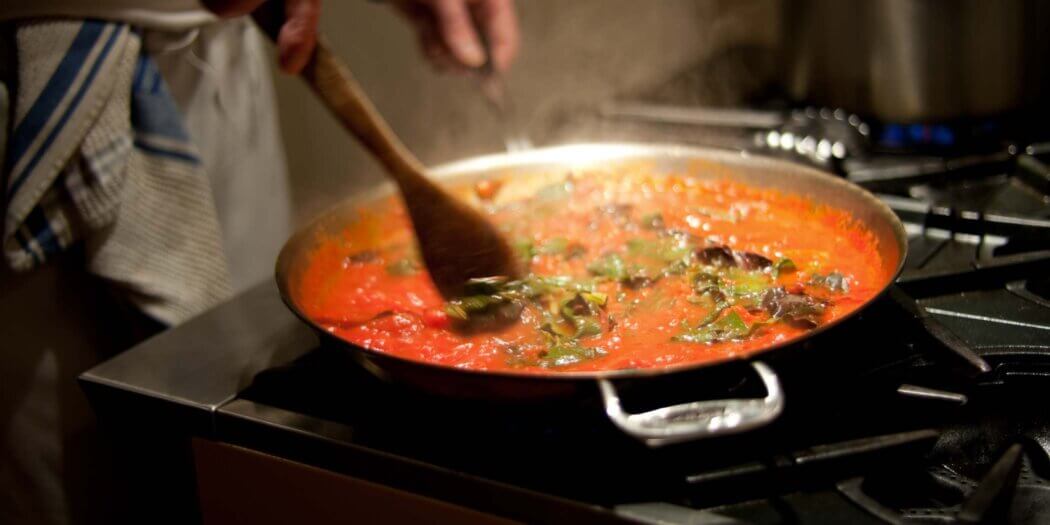
Quick Answer
How do you thicken sauce?
The most common way to thicken sauce is by using flour. You can create a slurry or roux using flour to create a thicker sauce.
Sauce is a key element to most recipes and can even make or break a dish — however, when the consistency of the sauce is too thin (we’re looking at you, gravy) it can disrupt the flavor, moisture and even texture of your favorite foods.
The good ol’ spoon trick can determine if your sauce is too thick or thin. All you have to do is dip the back of a spoon into the sauce, and if it is smooth and velvety then your sauce is cooked to perfection.
But what if your sauce isn’t the right consistency?
There are several methods if you are unsure how to thicken sauce. You can add tomato paste to tomato-based sauces for extra texture or create a roux with flour, or even reduce some of the liquid.
From flour to arrowroot, let’s review some of the common thickening agents.
Table of Contents:
- How to thicken sauce by reducing liquid
- How to thicken sauce with cornstarch
- How to thicken sauce with flour
- How to thicken sauce with egg yolks
- How to thicken sauce with butter
- How to thicken sauce with arrowroot
- How to thicken sauce with tomato paste
- How to thicken sauce with beurre manié
How to make a sauce thicker
If your sauce isn’t thick enough for your liking, you can perform a few methods to add more thickness.
Reduction is one of the easiest ways to thicken sauce because you just reduce the amount of liquid with a few extra minutes of boiling. You can keep the sauce on a full boil or simmer, but make sure you leave the sauce uncovered to let the steam evaporate.
You can also thicken the sauce by adding additional ingredients like flour or egg yolks. These methods require a few extra steps, but the results are worth it.
Keep reading to discover how to thicken sauce with readily available ingredients.
Different ways to thicken sauce
Reduction isn’t the only way to thicken sauce. While flour is often used, there are plenty of alternatives.
How to thicken sauce by reducing liquid
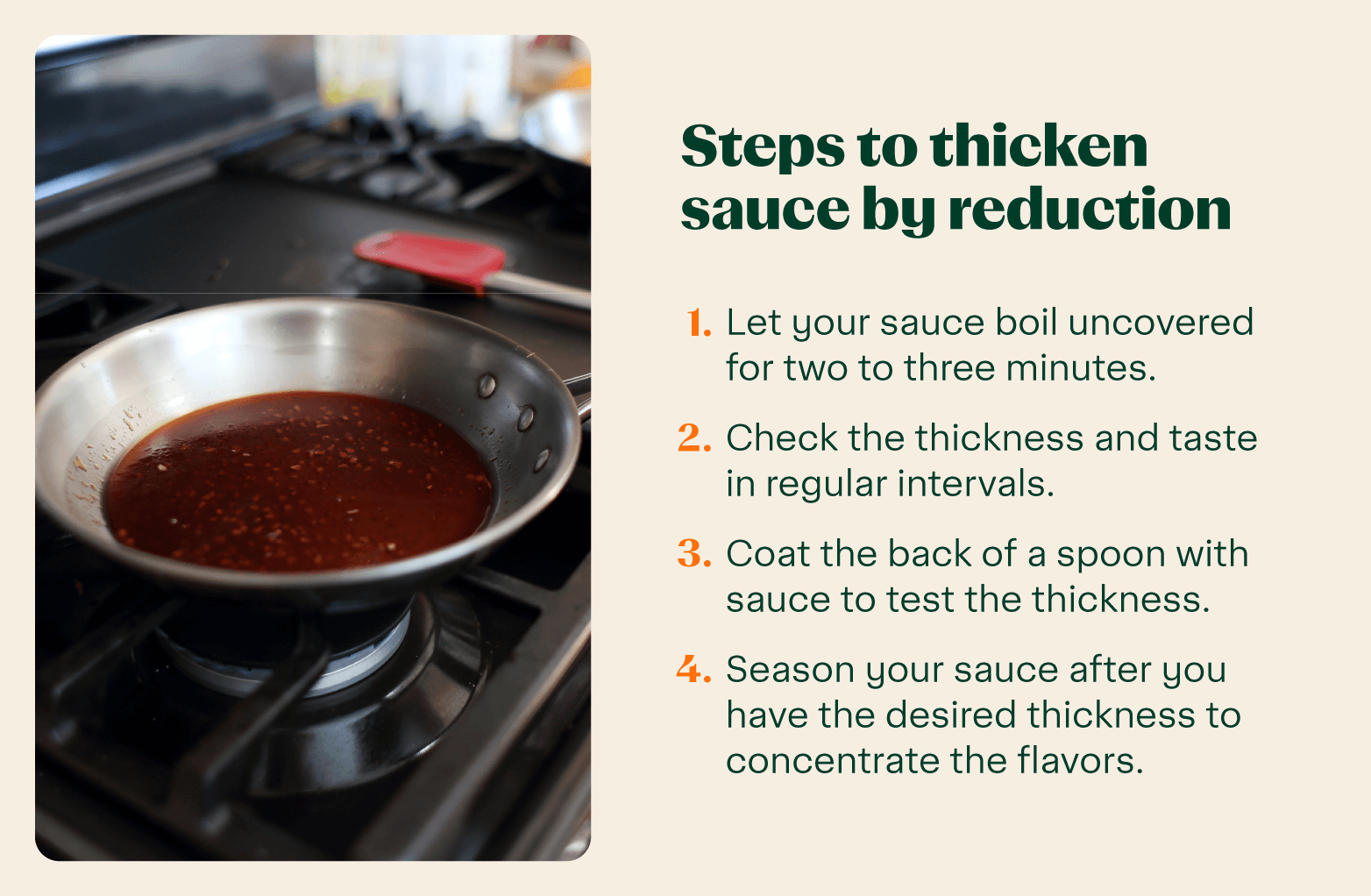
As we mentioned before, the easiest way to make a sauce thicker is by reducing the amount of liquid. This can be done by bringing the uncovered sauce to a medium or full boil.
By reducing the amount of liquid in the sauce you are also shifting the flavors. Let your sauce boil for two to three minutes and check the thickness and taste in regular intervals.
Why it works: As existing water evaporates the liquid becomes denser and the compounds of your mixture solidify.
When to use it: Reducing liquid is best for sauces that are slightly too thin like marinara sauces, BBQ glazes and braising liquids.
Steps to use it:
- Let your sauce boil for two to three minutes
- Check the thickness and taste in regular intervals
- Coat the back of a spoon with sauce to test the thickness
- Season your sauce after you have the desired thickness to concentrate the flavors
How to thicken sauce with cornstarch
Cornstarch is a great gluten-free alternative to thicken sauce. This thickening agent is easily available and fairly inexpensive.
When using cornstarch to thicken sauce it’s important to watch your measurements to avoid thickening your sauce too much.
Cornstarch tends to break down acid, so avoid using it to thicken acidic sauces.
Why it works: Cornstarch is widely available, translucent and won’t alter the color or flavor of your sauces. When you heat this carbohydrate derived from corn it becomes a thick, gelatinous consistency.
When to use it: Use cornstarch for clear sauces like stocks or soy-based liquids. You can also use cornstarch to thicken pudding and custard, stir fry, gravies and curry sauces.
Steps to use it:
- Add 1 tablespoon of cornstarch to 1 tablespoon of cold water
- Whisk the cornstarch and water together to create a slurry
- Pour your slurry into sauce on medium heat
- Bring the sauce to a boil for one minute
- Coat the back of a spoon with the sauce to see if it is thick enough
How to thicken sauce with flour
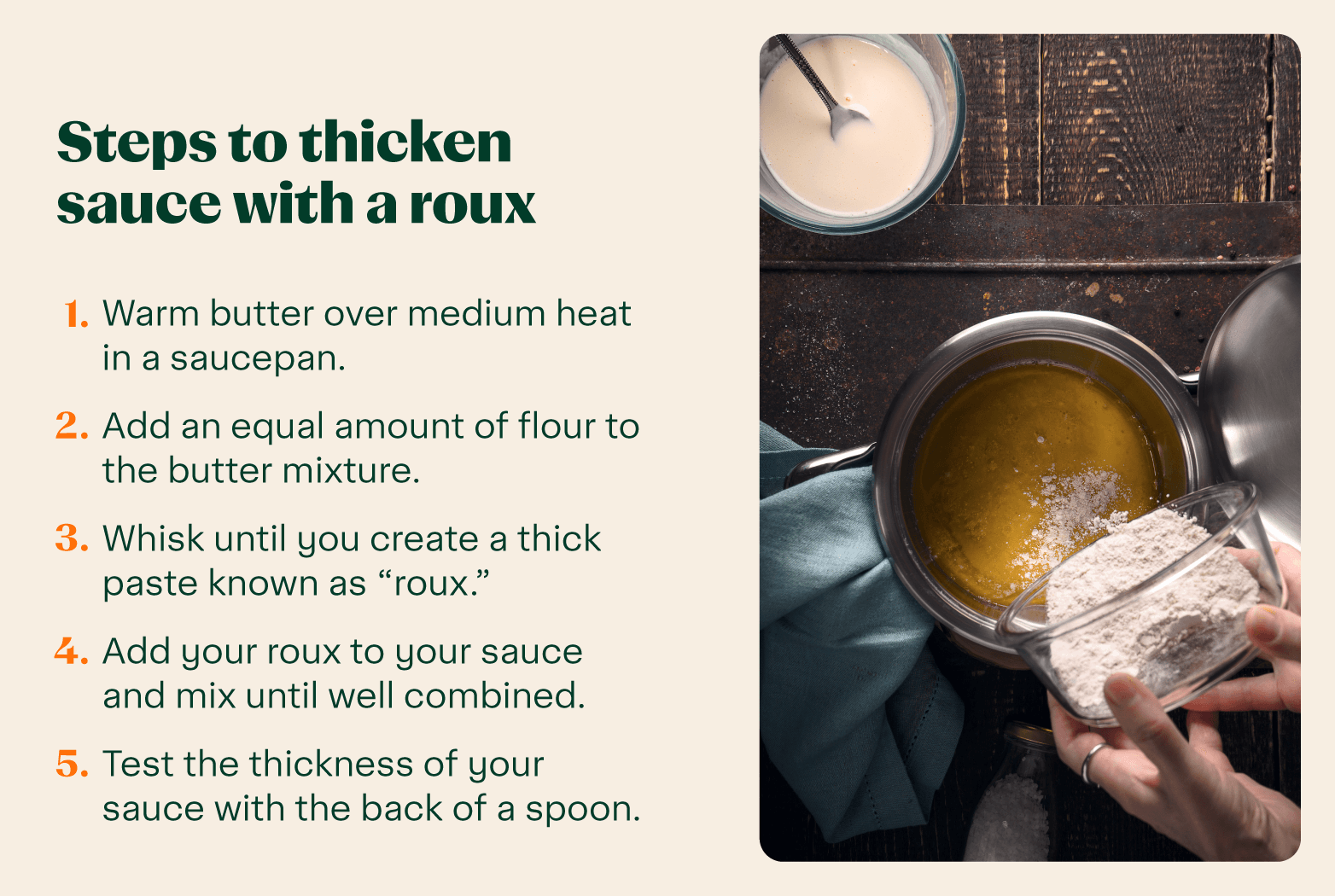
If you don’t have a gluten sensitivity, then you can thicken your sauce with flour by creating a slurry or roux.
The roux ratio is equal parts flour and a source of fat — most people use butter. A slurry is flour combined with water to help thicken sauce.
Why it works: When you add flour into your sauce, the starches expand to help add more thickness to your liquid.
When to use it: Use flour to thicken soups, gravy, dairy-based sauces and stews.
Steps to create a roux:
- Warm butter over medium heat
- Add an equal amounts of flour as butter to the saucepan
- Whisk until you create a thick, golden paste
- Add your roux to your sauce and mix until well combined
- Test the thickness of your sauce with the back of a spoon
Steps to create a slurry:
- Add 2 tablespoons of flour for every 1/4 cup of cold water
- Whisk until slurry is smooth
- Add slurry mixture to sauce and heat over medium
- Stir until you reach your desired thickness
- Test your sauce by coating it with the back of your spoon
How to thicken sauce with egg yolks
Did you know that you can add one or two egg yolks to your sauce to sub for cornstarch to increase the thickness?
You can add more yolks depending on how much sauce you are making, but a good rule of thumb is to start off with one or two. To avoid egg yolks from curdling, you can add hot sauce or a small amount of the sauce you are cooking.
Why it works: The protein in eggs helps thicken sauce when heated.
When to use it: Add egg yolks to pasta sauces, salad dressings, cream-based sauces and custards.
Steps to use it:
- In a bowl, separate egg yolks from the whites
- Add in a small amount of the sauce to temper the egg yolks from curdling
- Whisk the egg mixture into the rest of the sauce
- Dip your spoon into the sauce to test its thickness
How to thicken sauce with butter
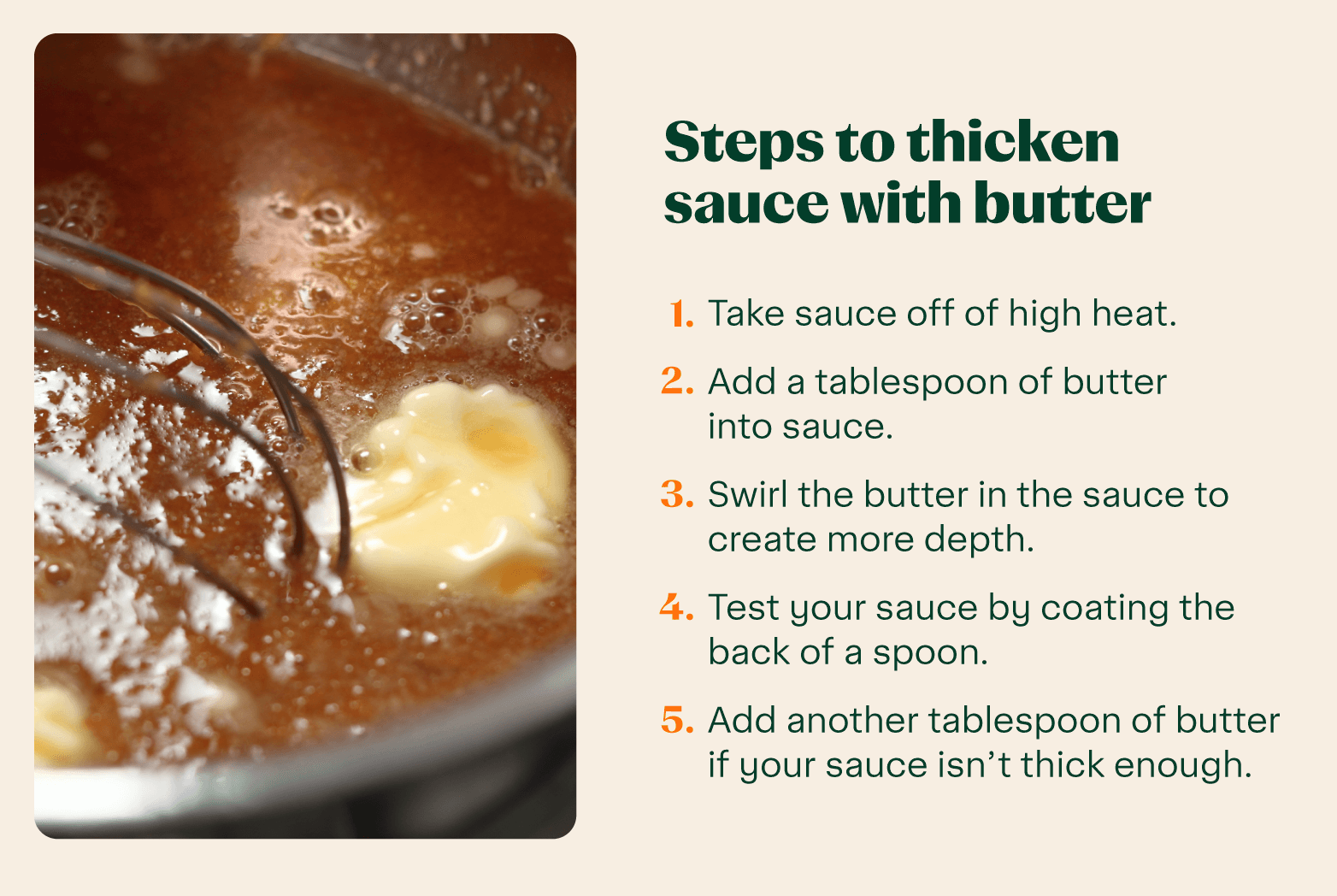
Give your sauce an extra boost with the assistance of butter. This food-thickening agent should be completed toward the end of cooking because the butter will break if exposed to high heat.
Make sure to start off with only a small amount of butter to avoid adding too much moisture to the sauce.
Why it works: A slice of butter will slightly thicken the sauce while adding richness and creating a glossy texture.
When to use it: Add butter to pan and pasta sauces that don’t require much thickness.
Steps to use it:
- Take sauce off of high heat
- Add a tablespoon of butter and into the sauce
- Swirl the butter in the sauce to create more depth
- Test your sauce by coating the back of a spoon
- Add another tablespoon of butter if your sauce isn’t thick enough
Grab it now on Instacart:
How to thicken sauce with arrowroot
Arrowroot is a gluten-free thickening agent that is similar to cornstarch, but comes from the tropical plant arrowroot tuber.
You can use arrowroot as a cornstarch replacement, but avoid adding it to dairy-based sauces because it creates a slimy consistency.
Why it works: Arrowroot thickens identical to cornstarch, but can thicken sauce even at a lower temperature. It also doesn’t break when combined with acids, unlike cornstarch.
When to use it: Use arrowroot for stocks, soy-based liquids and acidic sauces.
Steps to use it:
- In a bowl, add 1 tablespoon of arrowroot to 1 tablespoon of cold water
- Whisk the arrowroot and water together to create a slurry
- Add slurry to your sauce and put on medium heat
- Boil the sauce for one minute
- Check the thickness of your sauce by coating the back of a spoon with it
How to thicken sauce with tomato paste
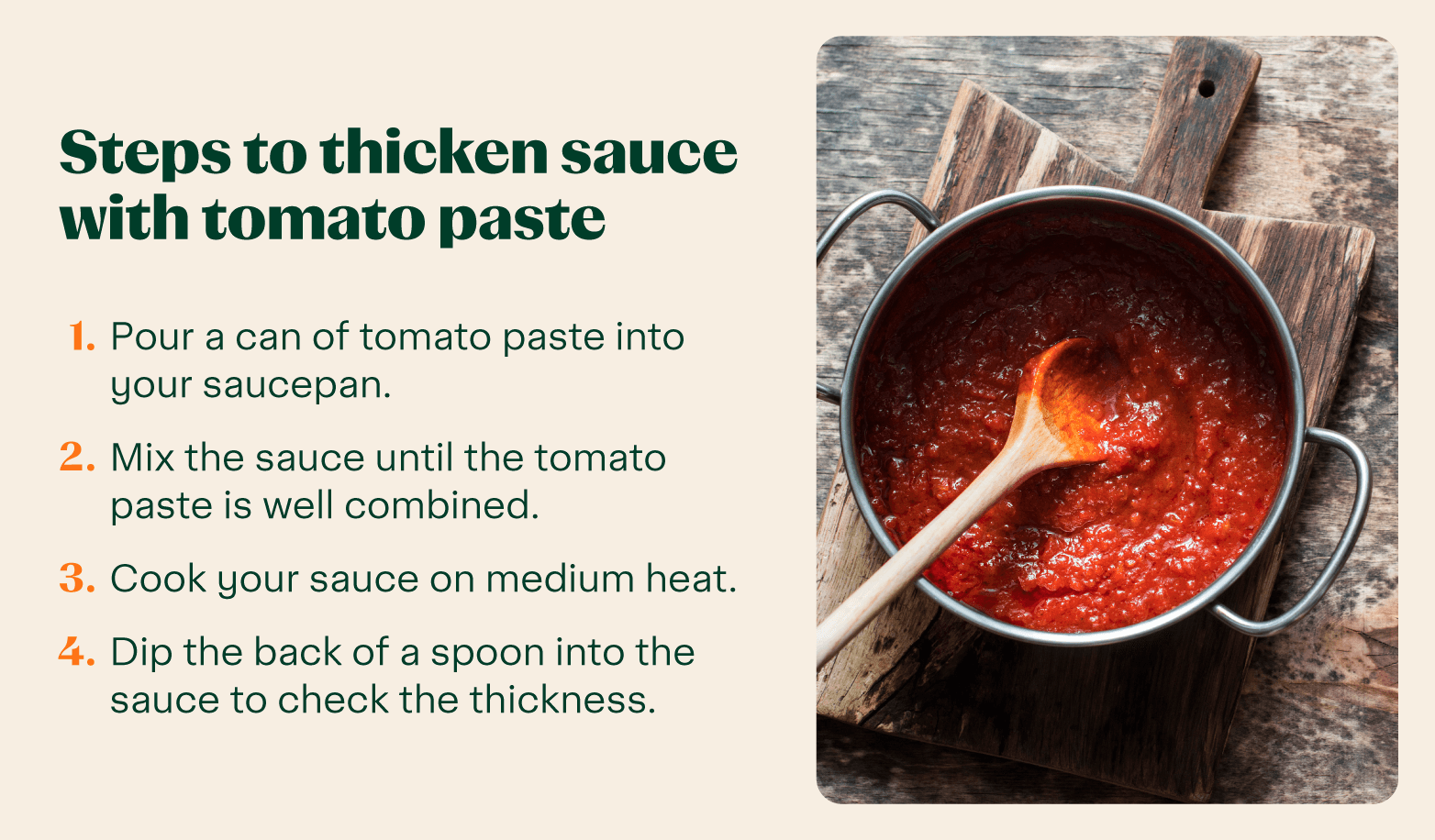
You can thicken sauce with tomato paste at the start of your recipe to ensure a perfect consistency. When you heat tomato paste, it caramelizes the sugars and releases oils.
It’s not recommended to add tomato paste to dairy-based sauces because it could alter the taste.
Why it works: Tomato paste has a naturally thick texture, so when it’s added to liquid it acts as a thickening agent.
When to use it: Add tomato paste to tomato sauces, tomato soup, brown sauces and beef stews.
Steps to use it:
- Pour a can of tomato paste into your saucepan
- Mix the sauce until the tomato paste is well combined
- Cook your sauce on medium heat
- Dip the back on a spoon into the sauce to check the thickness
How to thicken sauce with beurre manié
You can thicken sauce with a kneaded butter mixture, called beurre manié. This process is similar to a roux, but you create the mixture off of heat.
Why it works: The softened butter and flour mixture kneaded into a dough consistency creates the perfect amount of thickness to any sauce, stew or soup.
When to use it: You can thicken any sauce, soup or stew with this method.
Steps to use it:
- Combine equal parts of softened butter and flour in a bowl
- Knead the butter until the texture is similar to modeling clay
- Add your beurre manié to your sauce
- Whisk the sauce on medium heat until well combined
- Continue cooking your sauce until it is done
- Check the thickness of the sauce by coating the back of a spoon with it
How to thicken sauce using cornstarch
Course: RecipesCuisine: SaucesDifficulty: EasyVaries
servings5
minutes10
minutesCornstarch is a gluten-free alternative to thicken sauce that won’t alter the color or flavor.
Ingredients
1 tablespoon of cornstarch
1 tablespoon of cold water
- Additional recommended supplies
Saucepan
Whisk
Large spoon
Directions
- Add 1 tablespoon of cornstarch to 1 tablespoon of cold water
- Whisk the cornstarch and water together to create a slurry
- Pour your slurry into sauce on medium heat
- Bring the sauce to a boil for one minute
- Coat the back of a spoon with the sauce to see if it is thick enough
Tools for thickening sauce
Good news! You do not need expensive or elaborate tools for thickening sauce.
Here are a few tools you can use to perform these cooking tasks:
- Bowl: Make sure the bowl is large enough to avoid any spillage.
- Whisk: This cooking utensil is perfect for blending together your food-thickening agents and your sauce seamlessly.
- Saucepan: Choose a saucepan that is large enough to cook your sauce without spillage.
- Thickening agent: You will need butter, flour, cornstarch or whichever thickening agent you choose to use.
Common problems with thickening sauce
Thickening a sauce may seem simple, but it often comes with challenges that affect texture, flavor or consistency. Here’s how to identify and fix these common problems.

It becomes clumpy
A clumpy sauce is often the result of improper mixing or adding thickening agents like cornstarch too quickly. When thickening with cornstarch, it’s crucial to dissolve it in cold water first to create a slurry before whisking it into the hot sauce. This ensures smooth incorporation and prevents lumps.
Sauce becomes too thin
If your sauce isn’t thickening as expected, it could be due to insufficient cooking time or not using enough thickener. For instance, when learning how to thicken your sauce without cornstarch, options like reducing the sauce by simmering or adding a roux (flour and fat mixture) can help achieve the desired consistency. Gradually adding and stirring in your thickener can prevent over-thinning.
It has a starchy taste
An overpowering starchy flavor often occurs when thickeners like cornstarch or flour aren’t cooked thoroughly. To avoid this, simmer the sauce for a few minutes after adding the thickener. If you’re using alternatives while figuring out how to thicken with cornstarch or other methods, ensure you allow enough cooking time to neutralize any starchy aftertaste.
How to thicken sauce: FAQ
Still unsure how to thicken sauces? We answered some of your burning questions below.
A sauce is thick enough if it is velvety smooth and coats the back of a spoon. If your sauce is too runny or too thick to stir, then it may require a thinning or thickening agent.
The thickness of your sauce is also based on personal preference unless you are in culinary school or a professional chef. Don’t be afraid to test out different methods to cook up the sauce to your liking.
Simmering sauce can thicken it, but it is recommended to boil out some of the excess liquid for faster results. If you simmer instead, it may take an additional five to 20 minutes to thicken your sauce.
Egg yolks, arrowroot, tomato paste or butter can thicken sauce in place of flour or cornstarch.
Plain flour thickens sauce because the starches expand as you add liquid to it, which leads to a thicker consistency.
By adding a thickening agent to homemade sauce you can change the consistency to make it thicker. You can add plain flour, butter or even arrowroot to your soup, stew, sauce or breakfast gravy for added thickness.
Saucy final thoughts
Now that you know how to thicken sauce, it’s time to put these agents to work. Remember you can use flour to thicken sauce if you do not have a gluten sensitivity, or you can use cornstarch or arrowroot as a substitute thickening agent.
If you find yourself in a pickle and are in need of a food-thickening agent, you can place a same-day order with Instacart. Receive your groceries to your doorstep without the hassle of going to the store.
Shop through Instacart to find the tools and ingredients you need to whip up the tastiest sauce with the perfect consistency. Place your order today!
Most Recent in Recipes

Recipes
How Long To Bake Sweet Potatoes in the Oven: Recipes, Tips & More
Are you on sweet potato duty this holiday season? No need to worry! If you haven’t prepared them before, you may be wondering how long to bake a sweet potato. Fortunately, we’ve got the answers…
Dec 23, 2024
Recipes
How To Cook Quinoa Perfectly: Easy Tips and Recipe Ideas
Cooking quinoa can feel a bit intimidating at first, but with a few tips and tricks, you’ll have perfectly fluffy quinoa ready to add to your favorite dishes. Whether you’re new to quinoa or simply…
Dec 19, 2024
Recipes
How To Boil Eggs for the Perfect Bite in 5 Steps
Boiling eggs might seem simple, but achieving that perfect bite — whether it's a soft, creamy yolk or a firm, golden center — can be a challenge. If you've ever searched for how to boil…
Dec 19, 2024












 A Crowd Pleasing Salsa Roja – Recipe Ideas From The Instacart Team
A Crowd Pleasing Salsa Roja – Recipe Ideas From The Instacart Team  “Old Smokeshow” Cocktail – Recipe Ideas From The Instacart Team
“Old Smokeshow” Cocktail – Recipe Ideas From The Instacart Team  A Light Greek Salad – Recipe Ideas From The Instacart Team
A Light Greek Salad – Recipe Ideas From The Instacart Team 

